
The tambourine is a musical instrument in the percussion family consisting of a frame, often of wood or plastic, with pairs of small metal jingles, called "zills". Classically the term tambourine denotes an instrument with a drumhead, though some variants may not have a head at all. Tambourines are often used with regular percussion sets. They can be mounted, for example on a stand as part of a drum kit, or they can be held in the hand and played by tapping or hitting the instrument.

The xylophone is a musical instrument in the percussion family that consists of wooden bars struck by mallets. Like the glockenspiel, the xylophone essentially consists of a set of tuned keys arranged in the fashion of the keyboard of a piano. Each bar is an idiophone tuned to a pitch of a musical scale, whether pentatonic or heptatonic in the case of many African and Asian instruments, diatonic in many western children's instruments, or chromatic for orchestral use.
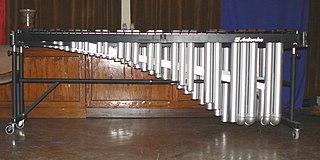
The marimba is a percussion instrument consisting of a set of wooden bars struck with yarn or rubber mallets to produce musical tones. Resonators or pipes are suspended underneath the bars to amplify their sound. The bars of a chromatic marimba are arranged like the keys of a piano, with the groups of two and three accidentals raised vertically, overlapping the natural bars to aid the performer both visually and physically. This instrument is a type of idiophone, but with a more resonant and lower-pitched tessitura than the xylophone. A person who plays the marimba is called a marimbist or a marimba player.
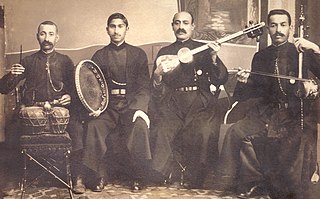
Azerbaijani music is the musical tradition of the Azerbaijani people from Azerbaijan Republic. It builds on folk traditions that reach back nearly 4,000 years. For centuries, Azerbaijani music has evolved under the badge of monody, producing rhythmically diverse melodies. Music from Azerbaijan has a branch mode system, where chromatisation of major and minor scales is of great importance.

A wooden fish -- also known as a Chinese temple block or wooden bell—is a wooden percussion instrument that originated from East Asia. It is used by monks and lay people in the Mahayana Buddhist tradition. It is often used during rituals usually involving the recitation of sutras, mantras, or other Buddhist texts. The wooden fish is mainly used by Buddhist disciples in China, Japan, Korea, and other East Asian countries use it in religious ceremonies. It may also be referred to as a Chinese block, Korean block or, rarely, as a skull. In most Zen/Ch'an Buddhist traditions, the wooden fish serves to keep the rhythm during sutra chanting. In Pure Land Buddhism, it is used when chanting the name of Amitabha.

The cabasa, similar to the shekere, is a percussion instrument that is constructed with loops of steel ball chain wrapped around a wide cylinder. The cylinder is fixed to a long, narrow wooden or plastic handle.

Marching percussion instruments are instruments specially designed to be played while moving. This is achieved by attaching the drum(s) to a special harness worn by the drummer, although not all marching bands use such harnesses and instead use traditional baldrics to sling their drums.
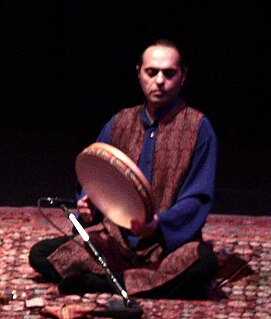
A dayereh is a medium-sized frame drum with jingles, used to accompany both popular and classical music in Iran, Tajikistan, Afghanistan, Bukharan Jews, Azerbaijan, the Caucasus, the Balkans, and many Central Asian countries such as Tajikistan, and Uzbekistan. Frame drums are also popular in many regions of Georgia, like Kartli, Kakheti, Tusheti, Samegrelo, Racha, and Imereti. This is a single headed percussion instrument which is not only found in Northern South Asia, Central Asia, and the Middle East, but also in parts of the Russian polar regions. The simple drum is formed by attaching a skin cover onto a wooden ring with glue and cloth ties. This is similar to the Persian daira and the Turkish def. Some daira have metal pieces attached to give them a tambourine-like quality.
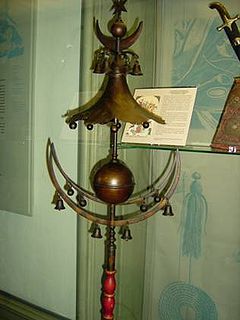
A Turkish crescent, (a smaller version is called a çevgen or çağana, Turkish jingle, Jingling Johnny, Schellenbaum, chapeau chinois or pavillon chinois, is a percussion instrument traditionally used by military bands. In some contexts it also serves as a battle trophy or object of veneration.

The bladder fiddle was a folk instrument used throughout Europe and in the Americas. The instrument was originally a simple large stringed fiddle made with a long stick, one or more thick gut strings, and a pig's-bladder resonator. It was bowed with either a notched stick or a horsehair bow.
Persian musical instruments can be broadly classified into three categories: classical, Western and folk. Most of Persian musical instruments spread in the former Persian Empires states all over the Middle East, Caucasus, Central Asia and through adaptation, relations, and trade, in Europe and far regions of Asia. In ancient era, the Silk road had an effective role in this distribution.

The naqqāra, nagara or nagada is a Middle Eastern drum with a rounded back and a hide head, usually played in pairs. It is thus a membranophone of the kettle drum variety.
The Zhu was a percussion instrument used in the Confucian court ritual music of ancient China. It consisted of a wooden box that tapered from the top to the bottom, and was played by grasping a vertical wooden stick and striking it on the bottom face. The instrument was used to mark the beginning of music in the ancient ritual music of China, called yayue. The instrument is rarely used today, with specimens appearing mainly in Chinese museums, although in Taiwan it is still used in Confucian ritual music by the Taiwan Confucian Temple.

The nagara or naghara is a drum used in the Middle East. There are several types of naghara, which is considered to be the lead instrument in folk ceremonies and weddings. The naghara differs in size and goes by various names such as "boyuk nagara", "cura nagara", "chiling naghara"(played with drum sticks), "Qoltuq nagara", gosha naghara (Naqareh) and "el naghara".
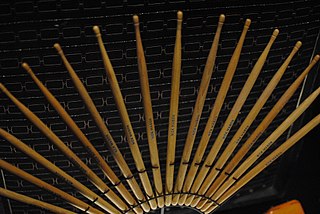
A drumstick is a type of percussion mallet used particularly for playing snare drum, drum kit and some other percussion instruments, and particularly for playing unpitched percussion.

Khartal is an ancient instrument mainly used in devotional / folk songs. It has derived its name from Sanskrit words ‘kara’ meaning hand and ‘tala’ meaning clapping. This wooden clapper is a Ghana Vadya which has discs or plates that produce a clinking sound when clapped together. It falls under the class of idiophones of self-sounding instruments that combine properties of vibrator and resonator.

The Azerbaijan State Orchestra of Folk Instruments is the first notable orchestra of folk instruments in Azerbaijan, affiliated with the Azerbaijan State Philharmonic Society. It was created in 1931, on the initiative of Uzeyir Hajibeyov, founder of professional Azerbaijani music, according to principles of the Symphony Orchestra.

Azerbaijani traditional musical instruments are designed for emotional color, rhythm, tempo and artistic features of Azerbaijani traditional music. Furthermore, it got through a very long path of historic development and carried many characteristic features of Azerbaijani traditional music. Many of string, wind and percussion instruments were made long before our era and developed over the course of the history and provided a basis for Azerbaijani traditional musical treasury.

Azerbaijani folk music combines the distinct cultural values of all civilisations that have lived in Azerbaijan and Iranian Azerbaijan region.
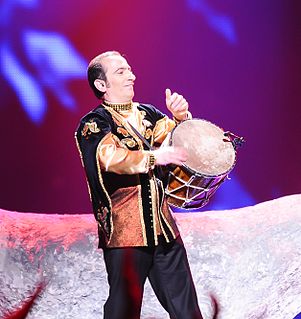
The Qoltuq nagara(Armpit drum) is a folk drum with double head that is played on one side with the bare hands. It is used in Armenia, Turkey, Iranian Azerbaijanis, Azerbaijan Georgia and other Caucasus regions. It has different names, according to the territory in which it is played. This membranophone is different from the dhol and nagara of India.

















